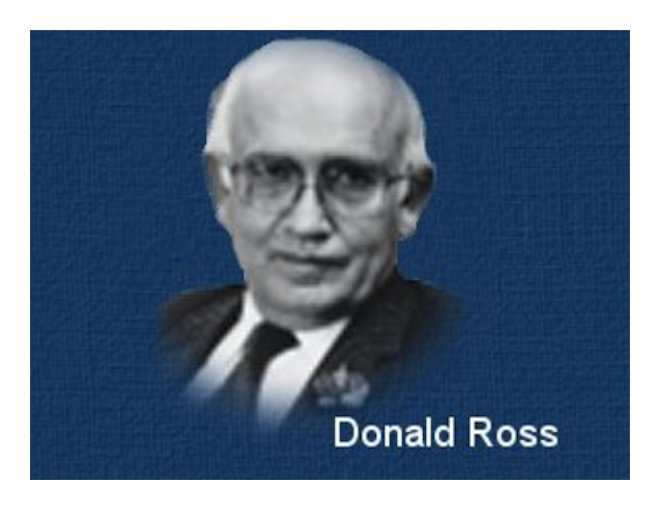Donald ROSS
Célébrités en cardiologie
(Celebrities in cardiology)

Donald ROSS . © Heart and Coeur ©
 Donald ROSS
Donald ROSS
Ross procedure
L'opération de Ross : une "Premiére" dans les années 1960 et nommée ainsi en l'honneur de son créateur,
le chirurgien anglais, Dr. Donald ROSS.
L'opération de Ross ou (Ross procedure) était et est toujours un des moyens innovateurs de remplacement valvulaire pour la valve aortique.
Le procédé de Ross, également connu sous le nom de procédé auto-greffe de la valve aortique,
est une technique chirurgicale spéciale pour remplacer une valve aortique malade.
Le procédé a été développé par le Dr. britannique de chirurgien Donald Ross en 1967.
À la différence d'autres opérations cardiaques qui utilisent une valve mécanique ou une valve de tissu prise d'un animal, le procédé de Ross remplace sur le patient sa valve aortique endomagée avec sa propre valve pulmonaire.
Dans ce cas précis la valve pulmonaire est indentique à la valve aortique utilisée ceci en matiére de tissu, de forme, de taille, etc.
Le taux de succés pour le procédé de Ross est plus de 97 pour cent et les résultats à long terme sont à ce jour excellent.
L'opération de Ross est conçu pour les personnes qui ont une sténose significative en plus des problémes de valve aortique ou de regurgitation ou de ces deux problémes.
 Donald ROSS
Donald ROSS
The pulmonary autograft procedure
The Ross Procedure, also known as the pulmonary autograft procedure for aortic valve disease, is a special surgical technique for replacing a diseased aortic valve.
The procedure was developed by the British surgeon Dr. Donald Ross in 1967.
Unlike other cardiac operations that use a mechanical valve or a tissue valve taken from an animal, the Ross Procedure replaces a patient's damaged aortic valve with his or her own pulmonic valve.
The pulmonic valve is used because it is the patient's own tissue and is identical in shape, size and strength to the aortic valve. Overall, the success rate for the Ross Procedure is over 97 percent and the long-term results have been excellent.
The Ross Procedure is designed for people who have significant aortic valve disease€”either stenosis or regurgitation or both. In the advanced stages, aortic valve disease can cause chest pain (angina), fainting during exercise, enlarged heart, shortness of breath or congestive heart failure.
Generally, valve replacement is when there are signs and symptoms of a progressive strain on the left ventricle, the main pumping chamber of the heart.
The left ventricle may become dilated and the wall thickened with extra muscle (hypertrophy). Symptoms may include heart pounding with exercise, reduced exercise tolerance or episodes of severe shortness of breath. In some patients, fainting, especially following exercise, may occur.
A variety of conditions may eventually lead to an abnormal aortic valve which requires replacement. A congenital condition, known as bicuspid aortic valve (the valve normally has three cusps), may over several decades lead to progressive leakage or serious obstruction. Rheumatic fever may involve the aortic valve. In certain families, a genetic trait causes weakness of the aortic valve and the wall of the aorta, producing a progressive leakage. In some older patients, the valve leaflets gradually become stiffened, heavily calcified and produce an obstructive condition known as calcific aortic stenosis. Aortic stenosis may also occur on a congenital basis.
No blood thinners (anticoagulants) are needed. If the aortic valve is replaced with a mechanical valve, the patient must take anticoagulants for the rest of his or her life. These medications have a small risk of excess bleeding or hemorrhage and the effects of the anticoagulants must be monitored with a blood test every 3 or 4 weeks and the dosage adjusted.
No postoperative deterioration by calcification of the valve—This can be a problem for patients who have their valve replaced with one from an animal (pig or cow). The younger the patient, the less durable the animal valve. The patient's pulmonic valve is the right size to replace the aortic valve.
No artificial material is used for the new aortic valve—This avoids many problems including rejection. Since the new aortic valve is created from the patient's own tissue, the tissue is alive and healthy, instead of being frozen or chemically treated.



